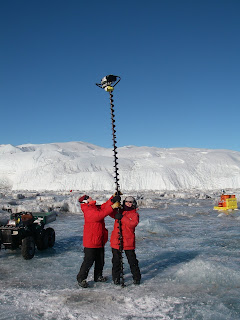 Crammed together, knee to knee, and bundled up in bright red parkas, our group endured the final flight of the season: McMurdo to Christchurch (an 8 hr journey north without a functioning heater). But even so, I sat with a smile, reliving my last month of plunging through lake ice, climbing atop ventifacts, winching up sulfer stinking water samples, hovering above mountaintops, wrapping and rewrapping a broken thumb with a cast too big to fit through my parka, standing across from the former president of Slovakia, witnessing the future of space exploration, and toasting to the new year with the sun beaming bright overhead...
Crammed together, knee to knee, and bundled up in bright red parkas, our group endured the final flight of the season: McMurdo to Christchurch (an 8 hr journey north without a functioning heater). But even so, I sat with a smile, reliving my last month of plunging through lake ice, climbing atop ventifacts, winching up sulfer stinking water samples, hovering above mountaintops, wrapping and rewrapping a broken thumb with a cast too big to fit through my parka, standing across from the former president of Slovakia, witnessing the future of space exploration, and toasting to the new year with the sun beaming bright overhead...Northbound, 30,000+ feet above the Transantarctic Mountains:

So its been a while since my last posting, and in the meantime, I've traveled over 10,000 miles, experienced over a 120 degreesF in temperature changes, sampled over a 100 liters of the most pristine, ancient lake water accessible on the planet, and have learned to appreciate any additional color to white! My experience in Antarctica could be described a unique, restless, phenomenal, cold, sunny, stressful, spectacular, daunting, thrilling, most unbelievable summer of my life. The continent seems to have crashed to the pole from another planet, along with a group of inhabits with the most bizarre and intriguing life stories one could imagine...

As temperatures warmed up, I devoted most my efforts to crossing melting moat ice along the lake's shores, but I did manage to snap some photos whenever possible. Here are some photos of my last month in Antarctica:
Down on the sea ice, the view once crawling out of an ice-cave:

Its windy atop the mountain:

Summertime at Blood Falls:

The furture of space exploration, NASA's ENDURANCE Robot rests in the "MonsterHaven," awaiting its next mission:

Don't Fall in the Lake! The Hole is 10ft in diameter:

Up the Wright Valley, a geologist's dream:

My last flight -- a front seat in the Kiwi chopper (thanks Rob):

Back in the Mac, cheers to the New Year...2008 will be a hard year to beat:

I'll leave it at this, with a farewell to 77 degrees south...











































